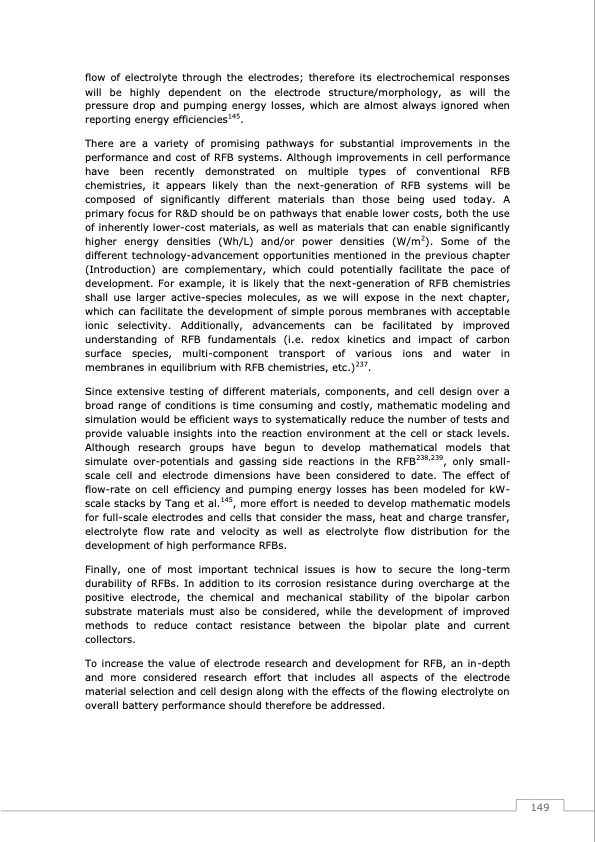
PDF Publication Title:
Text from PDF Page: 150
flow of electrolyte through the electrodes; therefore its electrochemical responses will be highly dependent on the electrode structure/morphology, as will the pressure drop and pumping energy losses, which are almost always ignored when reporting energy efficiencies145. There are a variety of promising pathways for substantial improvements in the performance and cost of RFB systems. Although improvements in cell performance have been recently demonstrated on multiple types of conventional RFB chemistries, it appears likely than the next-generation of RFB systems will be composed of significantly different materials than those being used today. A primary focus for R&D should be on pathways that enable lower costs, both the use of inherently lower-cost materials, as well as materials that can enable significantly higher energy densities (Wh/L) and/or power densities (W/m2). Some of the different technology-advancement opportunities mentioned in the previous chapter (Introduction) are complementary, which could potentially facilitate the pace of development. For example, it is likely that the next-generation of RFB chemistries shall use larger active-species molecules, as we will expose in the next chapter, which can facilitate the development of simple porous membranes with acceptable ionic selectivity. Additionally, advancements can be facilitated by improved understanding of RFB fundamentals (i.e. redox kinetics and impact of carbon surface species, multi-component transport of various ions and water in membranes in equilibrium with RFB chemistries, etc.)237. Since extensive testing of different materials, components, and cell design over a broad range of conditions is time consuming and costly, mathematic modeling and simulation would be efficient ways to systematically reduce the number of tests and provide valuable insights into the reaction environment at the cell or stack levels. Although research groups have begun to develop mathematical models that simulate over-potentials and gassing side reactions in the RFB238,239, only small- scale cell and electrode dimensions have been considered to date. The effect of flow-rate on cell efficiency and pumping energy losses has been modeled for kW- scale stacks by Tang et al.145, more effort is needed to develop mathematic models for full-scale electrodes and cells that consider the mass, heat and charge transfer, electrolyte flow rate and velocity as well as electrolyte flow distribution for the development of high performance RFBs. Finally, one of most important technical issues is how to secure the long-term durability of RFBs. In addition to its corrosion resistance during overcharge at the positive electrode, the chemical and mechanical stability of the bipolar carbon substrate materials must also be considered, while the development of improved methods to reduce contact resistance between the bipolar plate and current collectors. To increase the value of electrode research and development for RFB, an in-depth and more considered research effort that includes all aspects of the electrode material selection and cell design along with the effects of the flowing electrolyte on overall battery performance should therefore be addressed. 149PDF Image | Redox Flow Batteries Vanadium to Earth Quinones

PDF Search Title:
Redox Flow Batteries Vanadium to Earth QuinonesOriginal File Name Searched:
FJVG_TESIS.pdfDIY PDF Search: Google It | Yahoo | Bing
Salgenx Redox Flow Battery Technology: Salt water flow battery technology with low cost and great energy density that can be used for power storage and thermal storage. Let us de-risk your production using our license. Our aqueous flow battery is less cost than Tesla Megapack and available faster. Redox flow battery. No membrane needed like with Vanadium, or Bromine. Salgenx flow battery
| CONTACT TEL: 608-238-6001 Email: greg@salgenx.com | RSS | AMP |